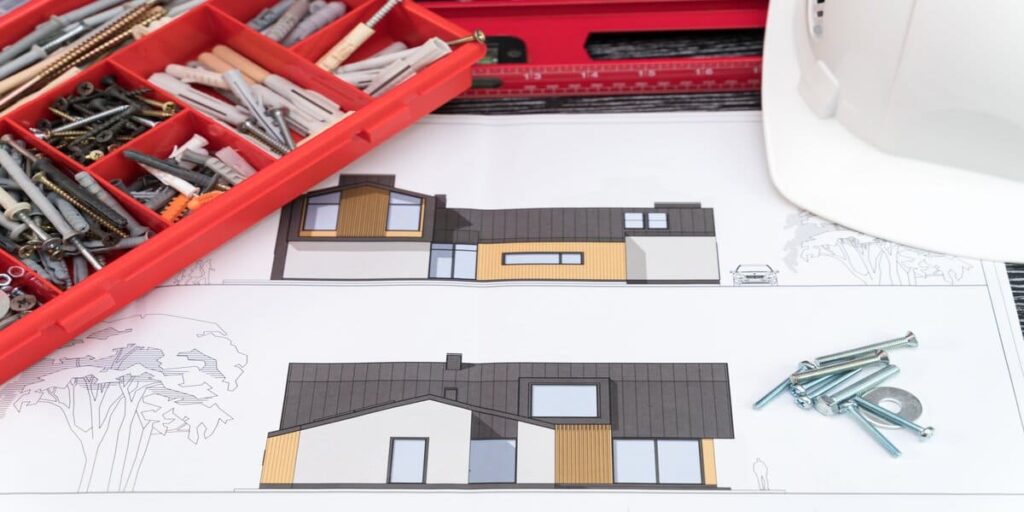“Change is like painting an old house. At first, it’s the same structure, but with each stroke of the brush, it transforms into something vibrant and new, showing us that beauty often lies in the renewal, not just the existing.”
Now, your home is aging and no longer suiting your lifestyle, and you plan on making improvements on it. Will you opt for a renovation? Or will you go for a complete remodeling?
Many people often use the terms ‘renovation’ and ‘remodeling’ interchangeably, but they, in fact, mean different things in home improvement. This common misunderstanding can lead to mismatched expectations and project outcomes. So, if you’re seeking to have either minor or major improvements in your home, you must first understand what renovation and remodeling means.
Renovation
Renovation refers to restoring or updating an existing structure. In this process, you are focusing on reviving the original condition or making it new without altering its fundamental design. Common renovation activities include painting walls, refinishing floors, replacing fixtures and hardware, and updating electrical and plumbing systems. For example, if you want to repaint and update the hardware in your 1960s kitchen or refinish the original hardwood floors in your vintage home, then we can say that you’re making a renovation.
Remodeling
Remodeling involves big changes to a space’s layout, structure, or function, often transforming it into something entirely different from its original design. This can include altering the floor plan, knocking down walls for an open concept, adding new rooms or structures, or completely changing the use of a space. A classic remodeling example is converting an attic into a livable loft or a garage into a home office. Another instance is removing a wall to combine a kitchen and living area into an open-plan space.

The Scope and Scale of Renovation vs. Remodeling Your Home
Renovation
Scope: Renovation typically involves minor changes to restore or update an existing space. This includes activities like repainting, repairing fixtures, or updating appliances, all of which maintain the space’s original layout and design.
Scale: Renovations are generally less extensive than remodels, focusing on cosmetic or functional updates rather than structural changes. With this, they tend to be less expensive and require a shorter completion time.
Remodeling
Scope: Remodeling goes beyond mere updates, involving major structural changes and alterations to the layout of a space. This can include modifying or removing walls, changing the floor plan, or adding new rooms or architectural features.
Scale: Due to the work involved, remodeling projects are typically more extensive than renovations. If you plan to remodel your home, you must prepare a higher budget due to structural modifications, the need for more complex planning, and potentially longer timelines.
Costs and Budgeting
Cost factors in Renovation
Materials: The cost of materials in renovation varies depending on the quality and type selected. For instance, choosing high-end finishes and standard materials can greatly affect the overall expense.
Labor: Labor costs in renovation projects depend on the complexity and skill required for the tasks. Professional fees for painters, electricians, and carpenters are typical expenses.
Duration: The length of the renovation project can impact the total cost. Longer projects might have additional labor charges, rental fees for equipment, or changing material costs.
Cost Factors in Remodeling Your Home
Structural Changes: The structural changes in remodeling often cost a lot. This includes expenses related to altering load-bearing walls, adding extensions, or modifying the building’s foundation, which requires more materials and specialized labor.
Permits and Regulations: Obtaining permits and ensuring compliance with local building codes can add to the cost of a remodeling project. These expenses can change depending on the location, scope of the work, and specific regulations that must be followed.
Professional Services: Remodeling usually requires the services of architects, design consultants, and specialized contractors. These professional fees, necessary for complex projects, can contribute a lot to the overall cost.

Time Considerations
Renovation Timeline
Shorter Projects: Renovation projects typically have a shorter timeline compared to remodeling. Since renovations usually involve cosmetic or functional updates without altering the structure, they can often be completed in days or weeks, depending on the project’s scope.
Factors Affecting Duration: Several factors can affect how long renovation takes, including the availability of materials, the extent of the updates, and the workforce’s efficiency. Unforeseen issues like delays in material delivery or discovering underlying problems (like electrical issues or mold) can also extend the timeline.
Remodeling Timeline
Longer Duration Projects: Remodeling projects generally take longer due to their complexity and the extent of changes involved. These projects can span several weeks to months, especially when structural modifications or big layout alterations are part of the plan.
Complexity and Factors Affecting Timelines: The timeline for a remodeling project is influenced by its complexity, the scope of work, and the need for specialized labor. It can also be affected by factors such as obtaining permits, the intricacy of design plans, and coordinating various contractors. Unexpected challenges like structural surprises uncovered during the remodel can also further extend the timeline.
Choosing Between Renovation and Remodeling
Assessing Needs and Goals
Functionality vs. Aesthetics: When choosing between renovation and remodeling, decide whether the primary goal is to improve functionality or aesthetics. Renovation often focuses on aesthetic updates like painting and flooring, whereas remodeling can alter the functionality of a space, like changing a room’s layout or purpose.
Space Requirements: Assessing space requirements is very important. Renovation might suffice if the current space is adequate but needs a refresh or minor changes. However, remodeling could be the more suitable option if there’s a need for more space, better flow, or a completely different layout.
Long-term Impact
Property Value: Choosing between renovation and remodeling your home can affect property value differently. Renovations, while often less costly, can greatly improve the appeal of a property with cosmetic upgrades. Remodeling, on the other hand, can increase property value by adding usable space or modernizing areas like kitchens and bathrooms, making the property more attractive to future buyers.
Living Comfort: Homeowners also need to think about the impact of home improvements on living comfort. Renovations can refresh a space, making it more pleasant and functional within the existing layout. Remodeling can greatly improve living comfort by reconfiguring spaces to suit the occupants’ lifestyle, such as creating an open-plan living area or adding an en-suite bathroom for convenience.

Planning and Execution
Planning for Renovation
Steps in Planning: When planning for a renovation, determine what needs to be updated or repaired. Next, create a detailed plan, including design preferences and material selections. Following this, establish a budget and timeline. Finally, consider logistical aspects such as ordering materials and scheduling work.
Hiring Professionals vs. DIY: Deciding between hiring professionals and undertaking a DIY approach depends on the project’s complexity and the individual’s skills. Hiring professionals for tasks requiring specialized knowledge, such as electrical work or plumbing, is advisable for safety and quality. A DIY approach can be cost-effective and personally rewarding for simpler tasks like painting or minor installations.
Planning for Remodeling
Design Considerations: This involves aesthetic choices and functional aspects like space utilization, flow between rooms, and compliance with building codes. It’s important to envision the result and how it will serve the needs and lifestyle of the occupants. Factors like light, storage, and movement within the space must be included in the plan for a successful remodel.
Hiring Architects and Contractors: For a remodeling project to be successful, homeowners must hire the right professionals. An architect or a designer is often necessary for big structural changes, as they can provide expert guidance on design, space planning, and regulatory compliance. Contractors are also needed for executing the plan, handling construction, and ensuring quality. You must communicate your vision and expectations with these professionals for the success of your remodeling project.
Legal and Safety Considerations
Permits and Regulations
Importance of Compliance: Obtaining the necessary permits and adhering to local building codes and regulations is a required step in renovation and remodeling projects. Compliance ensures the safety and legality of the work being performed. It also avoids potential legal issues and fines that can arise from non-compliance. Permits can also be important when selling a property or claiming insurance because they prove that the renovations comply with local building codes, making the property safer and potentially increasing its market value.
Differences between Renovation and Remodeling: The requirements for permits and regulations often differ between renovation and remodeling. Renovation projects, especially cosmetic ones, may not always require permits unless they involve significant electrical or plumbing changes. Due to their structural nature, remediation projects typically require more extensive permitting, including building, electrical, and sometimes zoning permits, to make sure that the changes comply with local codes and safety standards.
Safety Concerns
During Construction: Safety during construction is very important in renovation and remodeling projects. This includes ensuring a safe work environment for contractors and inhabitants, properly using tools and equipment, and managing hazards like electrical wiring, structural changes, and potential exposure to harmful substances like asbestos or lead paint. Proper protective gear and adherence to safety protocols must be practiced to prevent accidents and injuries.
Post-Completion Safety: After completing a project, the safety of the living space must be ensured. This involves checking that all renovations or remodels are up to code, especially regarding electrical and structural integrity. The changes made, such as poor ventilation, moisture problems, or inadequate structural support, should not pose long-term hazards. Regular maintenance checks and quickly fixing any problems can keep the place safe and secure.

Environmental Impact and Sustainability
Eco-friendly Practices in Renovation
Adopting eco-friendly practices in renovation benefits the environment and can be cost-effective in the long run. This involves using sustainable materials, such as recycled or locally sourced products, which reduce the environmental footprint. Energy efficiency is another thing to make sure you look into, where upgrading to energy-efficient appliances, improving insulation, and installing LED lighting can greatly reduce energy consumption. To contribute to environmental sustainability, waste should be minimized during renovation by recycling and reusing materials where possible.
Sustainable Remodeling Options
Incorporating sustainable options in remodeling projects is a practice that can bring long-term environmental and economic benefits. One way is energy efficiency, achieved through solar panels, energy-efficient windows, and improved insulation. Water conservation should also be thought of; implementing low-flow fixtures and rainwater harvesting systems can greatly reduce water usage. Utilizing eco-friendly construction materials, such as bamboo flooring or recycled glass countertops, can minimize the environmental impact of the remodel.
Final Thoughts on Renovation and Remodeling
Choosing between renovating and remodeling your home depends on knowing their differences and what you need and want. Renovation, often less extensive and more cost-effective, focuses on aesthetic updates and minor functional improvements within the existing structure. Remodeling, on the other hand, involves bigger structural and layout changes, offering transformative results, which may be more costly and with longer project timelines. Homeowners can make the best choice for their space by thinking about their budget, what they want to achieve, and how it will affect their home’s value and comfort over time.
Transform your place, customize your space; will you renovate or will you remodel?

Frequently Asked Questions
Can I renovate my home on a tight budget?
Absolutely! Focus on high-impact, low-cost projects like painting, upgrading fixtures, and small DIY projects to refresh your space without breaking the bank.
How do I know if I need a renovation or a remodel?
Consider your goals: renovation is your path if you want to update the look or repair features without altering the layout or structure. If you need to change the space’s function, size, or layout, remodeling is the way to go.
Are permits necessary for all remodeling projects?
Not all, but most structural changes do require permits. It’s best to check with your local building authority to understand what is required for your specific project.
Is it possible to live at home during a major remodel?
It depends on the project’s scope. It might be more practical to arrange alternative living arrangements for extensive remodels, especially those involving key living areas like kitchens and bathrooms.
References
7 Must-Follow Tips for Starting a House Renovation



























